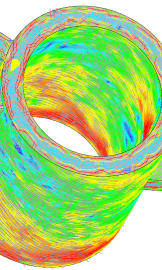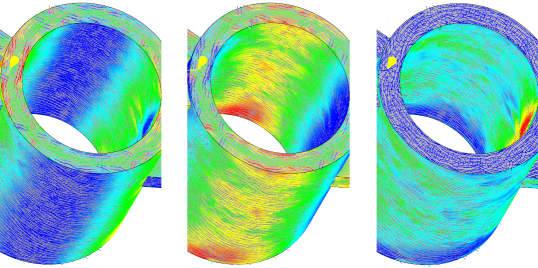Intermediate fiber orientation tensor result
The Intermediate fiber orientation tensor result shows how the probability of fibers aligning in a specified direction evolves over time.
Generate this result from an analysis that includes a Fill or Fill+Pack analysis for the following mesh types:
 Midplane
Midplane Dual Domain
Dual Domain 3D
3D
The Intermediate fiber orientation tensor result is generated when:
- A fiber filled material is selected
- The Fiber orientation analysis if fiber material option on the Process Settings Wizard - Fill Settings dialog is enabled.
- The Output intermediate fiber orientation results option on the Fiber Solver Parameters dialog is enabled.
Understanding the result
The Intermediate fiber orientation tensor result shows the probability of fibers aligning in a specified direction over time.

Figure 1 Intermediate fiber orientation tensor over time
Figure 1 shows the increase and then decrease of blue (low probability) tensors which illustrates how the fiber orientation tensor result changes through the injection cycle.
Midplane and Dual Domain analyses can also show the fiber orientation tensor at different positions through the thickness of the part at intermediate times if the profiles results output has also been enabled. A 3D analysis can only be displayed on the surface or a cutting plane.
Figure 2 Intermediate fiber orientation through thickness

Figure 2 shows, from left to right, the fiber orientation tensor from the middle of the part to the surface for a Dual Domain analysis.
There are two ways to view this result. These are:
Principal direction
The direction in which most fibers align is the called the first principal direction. A value close to 1 indicates a high probability that the fiber alignment is in this direction. The first principal direction may be close to, but may not necessarily coincide with, the material flow direction.

Figure 3 Intermediate fiber orientation result - principal direction
The second and third principal directions are based on, and are at right angles to, the first principal direction. Their values also indicate the probability of fiber alignment in their respective direction.
As this is a probability result, the sum of the probability for all three principal directions equals 1.
Tensor components
Fiber alignment in relation to a Cartesian Co-ordinate system can be displayed by selecting tensor components. This can be thought of as a 3x3 matrix. The Cartesian Co-ordinate system may be the Global Co-ordinate system or a Local Co-ordinate system defined by the user. The sum of the matrix diagonal adds up to 1. The off-diagonal values represent the amount the alignments vary from the co-ordinate axes.

Figure 4 Intermediate fiber orientation result - Txx, Tyy, Tzz
Figure 4 shows the same result as Figure 3, but from left to right, in the Txx, Tyy, and Tzz orientations of the Global Co-ordinate system.
Midplane and Dual Domain results
Investigate the fiber orientation tensor through both time and part thickness. Select  (Results tab > Properties panel > Plot Properties), select Single dataset from the Animate result over drop down list. By varying the Time and Normalized thickness values, fiber orientation through both time and part thickness can be understood.
(Results tab > Properties panel > Plot Properties), select Single dataset from the Animate result over drop down list. By varying the Time and Normalized thickness values, fiber orientation through both time and part thickness can be understood.
3D results
This result only animates the change in the fiber orientation tensor through the injection cycle on the surface or cutting plane.
Using the result
The anisotropic nature of a fiber filled material can result in uneven shrinkage as the material is stiffer in the fiber direction. To minimize undesirable shrinkage, you can:
- Change the injection location to change the fiber orientation in critical areas
- Introduce flow leaders and deflectors to direct the flow
- Alter the thickness and location of walls, if possible, to enable a more gradual change in flow direction
